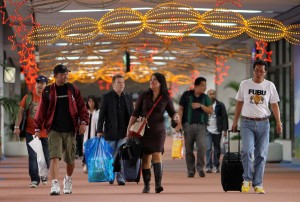MANILA, Philippines—Young Filipinos still make up the bulk of Overseas Filipino workers but there is a “very slight trend” showing that OFWs are getting older, according to a report by the National Statistical Coordination Board.
The report, “The Pinoy Diaspora: Where do our OFWs come from and where do they go?” posted on the NSCB web site said that although OFWs in the 25 to 29 age group comprise about a fourth of all Filipinos leaving for work abroad, data for the last three years show that the number of older workers is increasing slightly. OFWs in the 30 to 34 age bracket rose from 21 percent in 2008 to 21.7 percent in 2009, and 22.88 percent in 2010.
But overall, the average age of OFWs has been consistently 34.4 years, with males tending to be older at 36 compared to the females at 34, according to the report based on data from the Survey on Overseas Filipino Workers of the National Statistics Office.
Young OFWs however continue to dominate the NSCB figures, with data compiled over a three-year period indicating that overseas workers in the 25 to 29 age bracket make up 25.7 percent of OFWs in 2008, 24.8 percent in 2009, and 24.98 percent in 2010.
The results, the NSCB said, show that young Filipinos are leaving the country for work, spending what is perhaps their most productive years away from their country and families.
“When can we offer them job opportunities so that this group of young people, many of whom are almost fresh out of college, will be directly helping our economy grow rather than those of other countries? When can we contain the social cost of the Pinoy diaspora?” the NSCB report asked.
Not surprisingly, the number of OFWs is generally increasing, the same report indicated. From 2 million in 2008, it slipped to 1.91 million in 2009 but rose to 2.04 million in 2010, or about two percent of the country’s total population.
However, the sex distribution of OFWs is very different for Soccsksargen (central Mindanao), the Cagayan Valley, ARMM, and CAR. In these regions, for every 10 female OFWs, there were only from 3 to 5 male OFWs from 2008 to 2010.
“In fact, the sex ratio of OFWs for 2008 to 2010 is 100 females for every 123 males in Luzon, 100 females for every 119 males in the Visayas, and 100 females for 62 males in Mindanao. Why are there more women than men from Mindanao who leave the country for work?” the NSCB asked.
Female OFWs also outnumber their male counterparts in the younger age groups, with only 6 men for every 10 women aged 15 to 24 and 9 men for every 10 women aged 25 to 29. This calls attention to the greater vulnerability of our female OFWs compared to the males, the NSCB report noted.
Female OFWs are predominantly working as laborers and unskilled workers (domestic helpers), clerks, service workers, as well as shop and market sales workers, the NSCB said.
Regionally, Calabarzon sends out the most number of OFWs, followed by Central Luzon and the National Capital Region. Caraga (northeastern Mindanao), MIMAROPA (Mindoro, Marinduque, Romblon and Palawan), and CAR (Cordillera Autonomous Region) send out the least, each with a share of less than 2 percent. An increasing number of OFWs has been coming from the Ilocos Region, Central Visayas, and Cagayan Valley, NSCB said.
In terms of skills profile, about 76 percent of Filipino OFWs covered by the report are laborers and unskilled workers, service workers, shop and market sales workers, plant and machine operators and assemblers, or are engaged in trade and related work. Only 10 percent are professionals, technicians and associate professionals.
The same report indicated that 79 out of a hundred OFWS work all over Asia, including Saudi Arabia and the United Arab Emirates (UAE); 9 work in Europe, 8 in North and South America, 2 in Australia, and 2 in Africa. The three biggest OFW destination countries are Saudi Arabia (21 out of 100), UAE (15 out of 100), and Malaysia (10 out of 100).
In terms of the “most economically active population,” or those aged 20 to 39, OFWs are represented at 7 percent in 2008, 6.6 percent in 2009, and 6.9 percent in 2010, the NSCB said.
OFWs aged 45 and above made up 16.4 percent of OFWs in 2008, 16.2 percent in 2009, and 16.58 in 2010.
Thirty-five to 39-year-olds had a 15.1 percent share of OFW deployment in 2008, 15.5 percent in 2009, and 15.18 percent in 2010. Those aged 40 to 44 had an 11.8 percent share in 2008, 12 percent in 2009, and 11.39 percent in 2010.
The 15 to 24 age bracket had the smallest share with 10 percent in 2008, 9.8 percent in 2009, and 8.99 percent in 2010.
